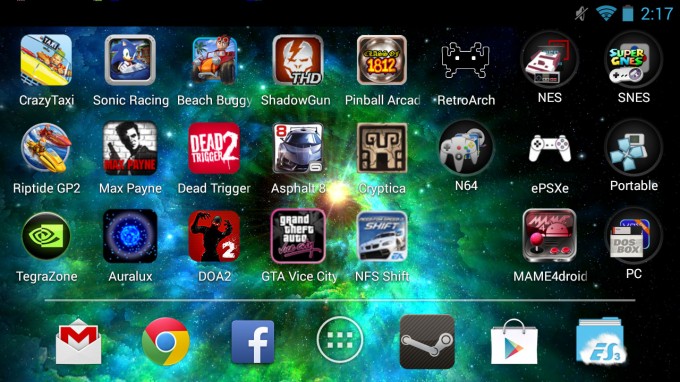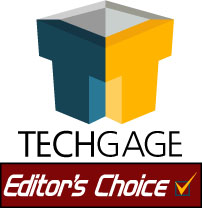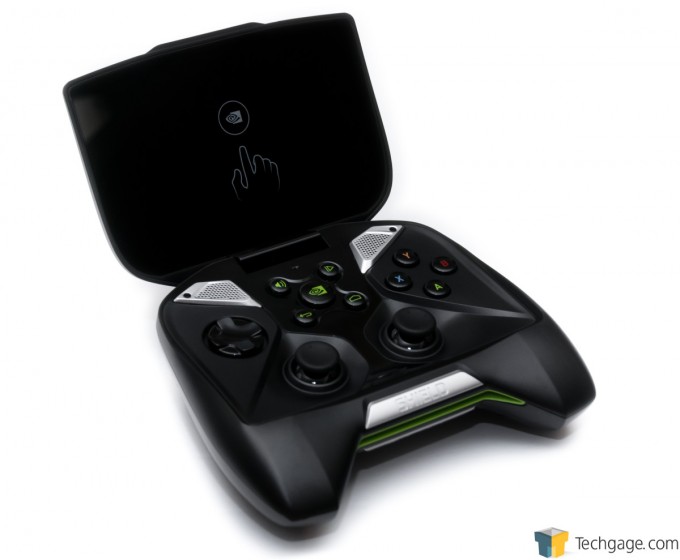- Qualcomm Launches Snapdragon 4 Gen 2 Mobile Platform
- AMD Launches Ryzen PRO 7000 Series Mobile & Desktop Platform
- Intel Launches Sleek Single-Slot Arc Pro A60 Workstation Graphics Card
- NVIDIA Announces Latest Ada Lovelace Additions: GeForce RTX 4060 Ti & RTX 4060
- Maxon Redshift With AMD Radeon GPU Rendering Support Now Available
The Ultimate Gaming Portable: NVIDIA SHIELD Review

Are you a portable gamer that’s tired of the restrictions that bog down most handhelds? Based on Android, NVIDIA’s SHIELD portable helps fix that problem. At the same time, it even goes a step further to improve the gamepad solution. At $300, SHIELD is on the pricier side – but is it worth it?
Page 5 – Performance, Battery Life & Final Thoughts
With that exhaustive look at SHIELD’s features out of the way, let’s move forward into a look at performance. We haven’t benchmarked a ton of mobile devices at Techgage up to this point, so our results below are just going to include the SHIELD and both the first and second gen ASUS Nexus 7.
Similar to our regular hardware benchmarking, our methodologies here require the device to be rebooted before testing, and left to sit for at least five minutes. Further, each test is run at least twice over, with each test run in the same order.
All three of the devices tested here feature quad-core ARM7-based SoCs, with the first-gen Nexus 7 (with Tegra 3) clocked at 1.2GHz, the second-gen clocked at 1.5GHz (with Adreno 320), and the SHIELD clocked at 1.9GHz (with Tegra 4).
| Nexus 7 Gen 1 | Nexus 7 Gen 2 | NVIDIA SHIELD | |
| 3DMark (Ice Storm Unlimited) | 3227 | 10464 | 18971 |
| MobileXPRT 2013 – User Experience | 98 | 98 | 100 |
| MobileXPRT 2013 – Overall Perf | 119 | 150 | 273 |
| Anomoly 2 Benchmark | 53407 | 198399 (1) | 913436 (2) |
| GFXBench – T-Rex HD Onscreen | 5.4 FPS | 15 FPS (1) | 40 FPS (2) |
| (1) 1920×1200; (2) 1280×720 | |||
With today’s ultra-high mobile resolutions – 1920×1200 on the second-gen Nexus 7 is an excellent example – it might seem a bit weak that NVIDIA equipped SHIELD with only 720p. However, as the gaming results above prove, it was absolutely the right decision to stick with 720p. SHIELD’s 5-inch display boasts an impressive ppi rating of 294, so at that point, a higher resolution is not going to improve the image’s crispness; if anything, a higher resolution would only impact performance in a bad way. Given that, would you rather 40 FPS or 15? That’s a no-brainer.
From an overall performance standpoint, MobileXPRT proved that there’s no discernible difference to the user experience between these devices, though the SHIELD is rated at almost twice as powerful as the latest Nexus 7 – not bad for a mobile that costs just 25% more (granted, it’s not fair to compare the two directly, as their market targets are quite different).
Performance-wise, SHIELD is top-rate – but what about battery-life?
| Battery Drain (One Hour) | Estimated Battery Life | |
| 720p H.264 Movie | 5% | ~20 Hours |
| Streaming 720p H.264 Movie | 6% | ~16 Hours |
| Simple Game (Super Mario World) | 14% | ~7 Hours |
| Using GameStream | 13% | ~7 Hours |
| Epic Citadel Benchmark | 19% | ~5 Hours |
| Tegra 4 Game (Riptide GP2) | 23% | ~4 Hours |
Where a gaming mobile is concerned, it’s hard to expect incredible battery-life, and SHIELD is no exception when we’re talking the latest games. Running the Tegra 4-based Riptide GP2, the SHIELD lasts about 4 hours. For a non-Tegra 4 game, we might get 5 hours out of one that still looks great. Want to run a game emulator? Expect closer to 7 hours.
The results that proved most impressive were video-related. The first time I ran the 720p one-hour test, I didn’t believe the result. Starting at 100%, the battery was about 95.5% after an hour – it didn’t seem realistic. Yet, after a second test with an entirely different video, the result held. Expect to get about 20 hours of H.264 720p playback out of SHIELD, and knock 20% off of that if it involves streaming (YouTube or off a home network).
Final Thoughts
Ahh, conclusion time. Is NVIDIA’s SHIELD worth picking up? If that question even has to be answered, I’d have to imagine that you didn’t read the rest of the review. But to be fair, there are multiple angles to look at, so let’s break it down.
SHIELD is not for everyone, especially those who take one look at it and wonder if it’d suit them. Since SHIELD’s launch, I’ve heard a number of different opinions. Some people love it like I do, others don’t see the point of owning one, and a select few actually own one but don’t use it as often as they expected. After seeing all of what SHIELD is capable of in this article, I’d like to assume that by now, you know whether or not it’s for you. I can tell you one thing: It’s definitely for me.
It might be best if I just lay the reasons out on the table.
As I mentioned in the intro, I’m a big gamer, but not a mobile one. That’s mostly because of the restrictions imposed on gaming handhelds I’ve owned (which have been all of the main ones up until the PS Vita), with regards to their freedom, and game selection. When companies like Nintendo or Sony need to give the a-OK to each game released on their respective consoles, and not to mention the huge costs that developers face when developing for those platforms, the selection is going to be limited.
SHIELD is Android, so the gaming potential is unlimited – there’s almost no barriers. You want to create a game and publish it to the Play Store? You can, with little hassle. That doesn’t mean it’s going to be good, but at least it will be there for people to access.
Of course, there are a number of games that don’t support a gamepad. NVIDIA has that covered with Gamepad Mapper, which in our testing performed well. It might be a little complicated to learn, but it helps fix a major issue that’s plagued those who want to use a gamepad for most or all of their mobile games.
On page 2, I placed SHIELD as the “ultimate” handheld for emulation lovers, and it takes mere minutes to understand the potential there. On the first night of using SHIELD, I had installed 10 different emulators, and kicked-off a quest in Dragon Warrior for the NES. I played a bit of Gex: Deep Cover Gecko for the PSone. I dabbled a bit with Wario Land for Virtual Boy (yes, really). I played one of my favorite arcade schmups through MAME, Progear. For the sake of not rambling on, I’ll stop here. Just believe me: Those who love game emulation and want it on-the-go, need a SHIELD. I plan on going into further detail in a future article.
 Your SHIELD desktop is bound to become full rather quickly
Your SHIELD desktop is bound to become full rather quickly
The fact that game emulation is possible on the SHIELD without roadblocks is owed to the fact it’s built around Android. It’s as open as a mobile platform is on the commercial side.
Past all of that, NVIDIA offers the ability to stream PC games to the SHIELD should you want that ability, and even turn the entire unit into a console. Done with gaming? Do whatever else you’d usually do on Android. Watch movies or hit-up YouTube, view photos, browse the Web, look for updates on Facebook, check your email, catch up on news, and so forth. The only thing it can’t do that a lot of other Android devices can is take a photo or act as a webcam – probably not a big issue for most people.
NVIDIA’s SHIELD might cost $100 more than a PS Vita, but just look at all it can do. It packs in top-of-the-line mobile graphics and a fast processor, offers unparalleled mobile software flexibility, can act as a console when connected to the TV, has a solid construction and reasonable design, and last but not least, lasts between 4~20 hours depending on what you’re using it for.
If I sound excited, it’s because I am. Editor’s Choice, no question. I can’t wait to see what NVIDIA brings to the table with SHIELD 2.
Pros
- Gamepad has a solid layout, despite the limitations imposed by form-factor.
- High ppi display is crisp, bright.
- Advanced features (GameStream, Console Mode) are very easy to set up.
- Intuitive to use; not much of a learning-curve.
- Fantastic SoC performance, both CPU and GPU-wise.
- Excellent built-in speakers; headphone jack produces solid audio also.
- Can stream PC games.
- A game emulation enthusiast’s dream.
- Can hook up to a TV and act as a media player.
- Ability to map a gamepad to games that don’t support it.
- Is flexible, thanks to the Android OS.
- Excellent battery-life across a variety of scenarios.
- Well-priced for all it can do (~$300 USD).
Cons
- Gamepad might not be comfortable for all gamers.
- A bit on the weightier side.
- Certain button-mapping limitations in emulators (which we’re investigating).
- GameStream works well, but expect to squint for some UI elements.
- Can experience a decent amount of video compression in GameStream if factors are not perfect.
- GameStream requires recent NVIDIA GPUs (GeForce GTX 650 and higher).

NVIDIA SHIELD
Support our efforts! With ad revenue at an all-time low for written websites, we're relying more than ever on reader support to help us continue putting so much effort into this type of content. You can support us by becoming a Patron, or by using our Amazon shopping affiliate links listed through our articles. Thanks for your support!






